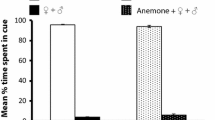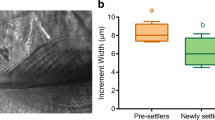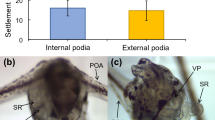Abstract
The rapid and often remote location of suitable habitats used by migrating organisms is often critical to their subsequent recruitment, fitness and survival, and this includes in the marine environment. However, for the non-feeding post-larval stage of spiny lobsters, effective settlement cues for habitat selection are critical to their success but are poorly described. Therefore, the current study examined whether acoustic and substrate cues have the potential to shorten the time to moulting and affect their subsequent nutritional condition in the pueruli of the southern spiny lobster, Jasus edwardsii. Individuals moulted to first instar juveniles up to 38 % faster when exposed to the underwater sound from two types of typical settlement habitat (coastal kelp- and urchin-dominated reefs) compared to those with no underwater sound. The settlement delay in the post-larvae without underwater sound also resulted in juveniles in poorer survival and nutritional condition as measured by their protein and lipid contents. In a separate experiment, post-larvae presented with seaweed and rock substrates were found to complete settlement and moult to juvenile by as much as 20 % faster compared to those on the sand and control treatments. Overall, the results are the first to demonstrate that the pueruli of J. edwardsii have the ability to detect and respond to underwater sound, as well as determining that both acoustic and substrate cues play a role in modulating physiological development during settlement.





Similar content being viewed by others
References
Acosta CA, Butler MJ (1997) Role of mangrove habitat as a nursery for juvenile spiny lobster, Panulirus argus, in Belize. Mar Freshw Res 48:721–727. doi:10.1071/mf96105
Andrew NL (1993) Spatial heterogeneity, sea urchin grazing, and habitat structure on reefs in temperate Australia. Ecology 74:292–302. doi:10.2307/1939293
Anger K (1987) The D0 threshold: a critical point in the larval development of decapod crustaceans. J Exp Mar Biol Ecol 108:15–30. doi:10.1016/0022-0981(87)90128-6
Bishop CD, Huggett MJ, Heyland A, Hodin J, Brandhorst BP (2006) Interspecific variation in metamorphic competence in marine invertebrates: the significance for comparative investigations into the timing of metamorphosis. Integr Comp Biol 46:662–682. doi:10.1093/icb/icl043
Bligh EG, Dyer WJ (1959) A rapid method for total lipid extraction and purification. Can J Biochem Physiol 37:911–917
Booth JD (1979) Settlement of the rock lobster, Jasus edwardsii (Decapoda: Palinuridae), at Castlepoint, New Zealand. N Z J Mar Freshw Res 13:395–406. doi:10.1080/00288330.1979.9515816
Booth JD (2001) Habitat preferences and behaviour of newly settled Jasus edwardsii (Palinuridae). Mar Freshw Res 52:1055–1065. doi:10.1071/MF01089
Booth JD (2006) Jasus species. In: Phillips BF (ed) Lobsters: biology, management, aquaculture and fisheries. Blackwell, Oxford, pp 340–358
Booth JD, Forman JS (1995) Larval recruitment in the red rock lobster, Jasus edwardsii New Zealand Fisheries Assessment Research Document 95/7, vol 95/7
Booth JD, Stewart RA (1992) Distribution of phyllosoma larvae of the red rock lobster Jasus edwardsii off the east coast of New Zealand in relation to the oceanography. In: Hancock DA (ed) Australian Society for Fish Biology workshop larval biology bureau of rural resources proceedings, 15. Australian Government, Canberra
Booth JD, Stewart RA (1993) Puerulus settlement in the red rock lobster, Jasus edwardsii New Zealand Fisheries Assessment Research Document 93/5, vol 93/5
Booth JD, Tarring SC (1986) Settlement of the red rock lobster, Jasus edwardsii, near Gisborne, New Zealand. N Z J Mar Freshw Res 20:291–297. doi:10.1080/00288330.1986.9516150
Butler MJ IV, Herrnkind WF (2000) Puerulus and juvenile ecology. In: Phillips BF, Kittaka J (eds) Spiny lobsters: fisheries and culture. Fishing News, Oxford, pp 276–301
Caputi N, Lestang S, Frusher S, Wahle RA (2013) The impact of climate change on exploited lobster stocks. Lobsters: biology, management, aquaculture and fisheries. Wiley, New York, pp 84–112
Cronin TW (1986) Photoreception in marine-invertebrates. Am Zool 26:403–415
Edmunds M (1995) The ecology of the juvenile southern rock lobster, Jasus edwardsii. PhD, University of Tasmania, Tasmania
Fitzgibbon Q, Battaglene S, Jeffs A (2013) The Achilles heel for spiny lobsters: the energetics of the non-feeding post-larval stage. Fish Fish. doi:10.1111/faf.12018
Flukes E, Johnson C, Ling S (2012) Forming sea urchin barrens from the inside out: an alternative pattern of overgrazing. Mar Ecol Prog Ser 464:179–194. doi:10.3354/meps09881
Forward RB Jr, Tankersley RA, Rittschof D (2001) Cues for metamorphosis of brachyuran crabs: an overview. Am Zool 41:1108–1122
Gardner C, Hartmann K, Hobday D (2011) Tasmanian rock lobster fishery 2009/2010. Tasmanian Aquaculture and Fisheries Institute, University of Tasmania
Gebauer P, Paschke K, Anger K (2003) Delayed metamorphosis in decapod crustaceans: evidence and consequences. Rev Chil Hist Nat 76:169–175
Gnaiger E (1983) Calculations of energetic and biochemical equivalents of respiratory oxygen consumption. In: Gnaiger E, Forstner H (eds) Polarographic oxygen sensors: aquatic and physiological applications. Springer, Berlin
Goldstein JS, Butler MJ (2009) Behavioral enhancement of onshore transport by postlarval Caribbean spiny lobster (Panulirus argus). Limnol Oceanogr 54:1669–1678. doi:10.4319/lo.2009.54.5.1669
Hallegraeff G, Beardall J, Brett S, Doblin S, Thomas P (2012) Phytoplankton. In: Poloczanska ES, Hobday A, Richardson AM (eds) A marine climate change impacts and adaptation report card for Australia 2009. NCCARF Publication 05/09
Hartmann K, Gardner C, Hobday D (2012) Tasmanian rock lobster fishery 2010/11. Tasmanian Aquaculture and Fisheries Institute, University of Tasmania
Hayakawa Y, Booth JD, Nishida S, Sekiguchi H, Saisho T, Kittaka J (1990) Daily settlement of the puerulus stage of the red rock lobster J. edwardsii at Castlepoint, New Zealand. Nippon Suisan Gakkaishi 56:1703–1716
Herremans M (1990) Can night migrants use interspecific song recognition to assess habitat? Le Gerfaut 80:141–148
Herrnkind WF, Butler MJ (1994) Settlement of spiny lobster, Panulirus argus (Lareille, 1804) in Florida Bay—pattern without predictability. Crustaceana 67:46–64
Hinojosa I, Green B, Gardner C, Jeffs A (2014) Settlement and early survival of southern rock lobster, Jasus edwardsii, under climate-driven decline of kelp habitats. ICES J Mar Sci. doi:10.1093/icesjms/fsu199
Huijbers CM et al (2012) A test of the senses: fish select novel habitats by responding to multiple cues. Ecology 93:46–55. doi:10.1890/10-2236.1
Hutto RL (1985) Habitat selection by nonbreeding, migratory land birds. In: Cody M (ed) Habitat selection in birds. Academic, New York, pp 455–476
Jeffs AG, Davis M (2003) An assessment of the aquaculture potential of the Caribbean spiny lobster, Panulirus argus. Proc Gulf Caribb Fish Inst 54:413–426
Jeffs A, Diebel CE, Hooker SH (1997) Arrangement and significance of pinnate sensory setae on antennae of the puerulus and post-puerulus of the spiny lobster, Jasus edwardsii (Palinuridae). Mar Freshw Res 48:681–686. doi:10.1071/MF97047
Jeffs AG, Willmott ME, Wells RMG (1999) The use of energy stores in the puerulus of the spiny lobster Jasus edwardsii across the continental shelf of New Zealand. Comp Biochem Phys A 123:351–357. doi:10.1016/s1095-6433(99)00073-2
Jeffs AG, Chiswell SM, Booth JD (2001a) Distribution and condition of pueruli of the spiny lobster Jasus edwardsii offshore from north-east New Zealand. Mar Freshw Res 52:1211–1216. doi:10.1071/MF01182
Jeffs AG, Nichols PD, Bruce MP (2001b) Lipid reserves used by pueruli of the spiny lobster Jasus edwardsii in crossing the continental shelf of New Zealand. Comp Biochem Phys A 129:305–311. doi:10.1016/s1095-6433(00)00348-2
Jeffs AG, Nichols PD, Mooney BD, Phillips KL, Phleger CF (2004) Identifying potential prey of the pelagic larvae of the spiny lobster Jasus edwardsii using signature lipids. Comp Biochem Physiol B 137:487–507. doi:10.1016/j.cbpc.2004.02.003
Jeffs AG, Montgomery JC, Tindle CT (2005) How do spiny lobster post-larvae find the coast? N Z J Mar Freshw Res 39:605–617
Johnson CR et al (2011) Climate change cascades: Shifts in oceanography, species’ ranges and subtidal marine community dynamics in eastern Tasmania. J Exp Mar Biol Ecol 400:17–32. doi:10.1016/j.jembe.2011.02.032
Kittaka J (1990) Ecology and behaviour of puerulus of spiny lobsters. La Mer 28:255–259
Kroodsma DE, Byers BE, Goodale E, Johnson S, Liu WC (2001) Pseudoreplication in playback experiments, revisited a decade later. Anim Behav 61:1029–1033. doi:10.1006/anbe.2000.1676
Leis JM, Carson-Ewart BM, Hay AC, Cato DH (2003) Coral-reef sounds enable nocturnal navigation by some reef-fish larvae in some places and at some times. J Fish Biol 63:724–737. doi:10.1046/j.1095-8649.2003.00182.x
Lesser JHR (1978) Phyllosoma larvae of Jasus edwardsii (Hutton) (Crustacea: Decapoda: Palinuridae) and their distribution off the east coast of the North Island, New Zealand. N Z J Mar Freshw Res 12:357–370. doi:10.1080/00288330.1978.9515763
Limbourn AJ, Babcock RC, Johnston DJ, Nichols PD, Knott B (2008) Post-settlement energy reserves in Panulirus cygnus: experimental effects of starvation on survival and nutritional condition. Mar Biol 153:445–456. doi:10.1007/s00227-007-0825-7
Ling SD, Johnson CR (2009) Population dynamics of an ecologically important range-extender: kelp beds versus sea urchin barrens. Mar Ecol Prog Ser 374:113–125
Ling SD, Johnson CR, Frusher SD, Ridgway KR (2009) Overfishing reduces resilience of kelp beds to climate-driven catastrophic phase shift. Proc Natl Acad Sci USA 106:22341–22345. doi:10.1073/pnas.0907529106
Linnane A et al (2010) Evidence of large-scale spatial declines in recruitment patterns of southern rock lobster Jasus edwardsii, across south-eastern Australia. Fish Res 105:163–171. doi:10.1016/j.fishres.2010.04.001
Lough JM (2009) Temperature. In: Poloczanska ES, Hobday A, Richardson AM (eds) A marine climate change impacts and adaptation report card for Australia 2009. NCCARF Publication 05/09
Marx JM (1986) Settlement of spiny lobster, Panulirus argus, pueruli in South Florida: an evaluation from two perspectives. Can J Fish Aquat Sci 43:2221–2227. doi:10.1139/f86-272
Montgomery JC, Jeffs A, Simpson SD, Meekan M, Tindle C (2006) Sound as an orientation cue for the pelagic larvae of reef fishes and decapod crustaceans. Adv Mar Biol 51:143–196. doi:10.1016/S0065-2881(06)51003-X
Moore FR, Aborn DA (2000) Mechanisms of en route habitat selection: how do migrants make habitat decisions during stopover? Stud Avian Biol 20:34–42
Mukhin A, Chernetsov N, Kishkinev D (2008) Acoustic information as a distant cue for habitat recognition by nocturnally migrating passerines during landfall. Behav Ecol 19:716–723. doi:10.1093/beheco/arn025
O’Connor NJ, Gregg AS (1998) Influence of potential habitat cues on duration of the megalopal stage of the fiddler crab Uca pugnax. J Crust Biol 18:700–709
Pawlik JR (1992) Chemical ecology of the settlement of benthic marine-invertebrates. Oceanogr Mar Biol Annu Rev 30:273–335
Pechenik JA (1990) Delayed metamorphosis by larvae of benthic marine invertebrates—does it occur—is there a price to pay. Ophelia 32:63–94
Pechenik JA (1999) On the advantages and disadvantages of larval stages in benthic marine invertebrate life cycles. Mar Ecol Prog Ser 177:269–297. doi:10.3354/meps177269
Pecl G et al (2009) The east coast Tasmanian rock lobster fishery—vulnerability to climate change impacts and adaptation response options. Report to the Department of Climate Change, Australia
Phillips B (2003) Rock lobster enhancement and aquaculture subprogram: towards establishing techniques for large scale harvesting of pueruli and obtaining a better understanding of mortality rates. Fisheries Research Report No. 144, Department of Fisheries, Western Australia
Phillips BF, Macmillan DL (1987) Antennal receptors in puerulus and postpuerulus stages of the rock lobster Panulirus cygnus (Decapoda: Palinuridae) and their potential role in puerulus navigation. J Crust Biol 7:122–135
Phillips BF, Penrose JD (1985) The puerulus stage of the spiny (rock) lobster and its ability to locate the coast. In: School of Physics and Geosciences WAIoT (ed), Report SPG 374/1985/AP92, p 48
Phillips B, Sastry A (1980) Larval ecology. In: Cobb J, Phillips B (eds) The biology and management of lobsters, vol II. Academic, New York, pp 11–57
Pine MK, Jeffs AG, Radford CA (2012) Turbine sound may influence the metamorphosis behaviour of estuarine crab megalopae. PLoS ONE 7:e51790. doi:10.1371/journal.pone.0051790
Popper AN, Fewtrell J, Smith ME, McCauley RD (2003) Anthropogenic sound: effects on the behavior and physiology of fishes. Mar Technol Soc J 37:35–40
Radford CA, Jeffs AG, Montgomery JC (2007) Directional swimming behavior by five species of crab postlarvae in response to reef sound. Bull Mar Sci 80:369–378
Radford CA, Jeffs AG, Tindle CT, Montgomery JC (2008a) Resonating sea urchin skeletons create coastal choruses. Mar Ecol Prog Ser 362:37–43. doi:10.3354/meps07444
Radford CA, Jeffs AG, Tindle CT, Montgomery JC (2008b) Temporal patterns in ambient noise of biological origin from a shallow water temperate reef. Oecologia 156:921–929. doi:10.1007/s00442-008-1041-y
Radford CA, Stanley JA, Tindle CT, Montgomery JC, Jeffs AG (2010) Localised coastal habitats have distinct underwater sound signatures. Mar Ecol Prog Ser 401:21–29. doi:10.3354/meps08451
Richardson AJ, McKinnon D, Swadling KM (2009) Zooplankton. In: Poloczanska ES, Hobday A, Richardson AM (eds) A marine climate change impacts and adaptation report card for Australia 2009. NCCARF Publication 05/09
Rodriguez SR, Ojeda FP, Inestrosa NC (1993) Settlement of benthic marine invertebrates. Mar Ecol Prog Ser 97:193–207
Schaub M, Schwilch R, Jenni L (1999) Does tape-luring of migrating Eurasian Reed-Warblers increase number of recruits or capture probability? Auk 116:1047–1053
Shears NT, Babcock RC (2002) Marine reserves demonstrate top-down control of community structure on temperate reefs. Oecologia 132:131–142. doi:10.1007/s00442-002-0920-x
Simpson SD, Meekan MG, Montgomery JC, McCauley RD, Jeffs A (2005) Homeward sound. Science 308:221
Simpson SD, Jeffs A, Montgomery JC, McCauley RD, Meekan MG (2008a) Nocturnal relocation of adult and juvenile coral reef fishes in response to reef noise. Coral Reefs 27:97–104
Simpson SD, Meekan MG, Jeffs A, Montgomery JC, McCauley RD (2008b) Settlement-stage coral reef fish prefer the higher-frequency invertebrate-generated audible component of reef noise. Anim Behav 75:1861–1868. doi:10.1016/j.anbehav.2007.11.004
Stanley JA, Radford CA, Jeffs AG (2010) Induction of settlement in crab megalopae by ambient underwater reef sound. Behav Ecol 21:113–120. doi:10.1093/beheco/arp159
Stanley JA, Radford CA, Jeffs AG (2011) Behavioural response thresholds in New Zealand crab megalopae to ambient underwater sound. PLoS ONE 6. doi:10.1371/journal.pone.0028572
Stanley JA, Radford CA, Jeffs AG (2012) Location, location, location: finding a suitable home among the noise. Proc R Soc Lond B 279:3622–3631. doi:10.1098/rspb.2012.0697
Stobutzki IC, Bellwood DR (1998) Nocturnal orientation to reefs by late pelagic stage coral reef fishes. Coral Reefs 17:103–110
Strain EMA, Johnson CR (2012) Intensive fishing of marine consumers causes a dramatic shift in the benthic habitat on temperate rocky reefs. Mar Biol 159:533–547. doi:10.1007/s00227-011-1833-1
Thorson G (1950) Reproductive and larval ecology of marine bottom invertebrates. Biol Rev 25:1–45
Wahle RA, Fogarty MJ (2006) Growth and development: Understanding and modelling growth variability in lobsters. In: Phillips B (ed) Lobsters: biology, management, aquaculture and fisheries. Blackwell, Oxford
Wilkens SL, Stanley JA, Jeffs AG (2012) Induction of settlement in mussel (Perna canaliculus) larvae by vessel noise. Biofouling 28:65–72. doi:10.1080/08927014.2011.651717
Wilkin JL, Jeffs AG (2011) Energetics of swimming to shore in the puerulus stage of a spiny lobster: can a postlarval lobster afford the cost of crossing the continental shelf? Limnol Oceanogr Fluids Environ 1:163–175. doi:10.1215/21573698-1504363
Zar HJ (1999) Biostatistical analysis, 4th edn. Prentice-Hall, Upper Saddle River
Acknowledgments
We thank staff and students, especially Miao Wang and Leo Zamora, for their assistance with logistics, and Jeff Forman for the supply of pueruli used in the winter experiments. This research was funded by the University of Auckland’s Faculty of Science’s Research and Development Fund and the Glenn Family Foundation. The work was conducted under University of Auckland Animal Ethics Committee approval number R930.
Author information
Authors and Affiliations
Corresponding author
Additional information
Communicated by Aaron J. Wirsing.
Rights and permissions
About this article
Cite this article
Stanley, J.A., Hesse, J., Hinojosa, I.A. et al. Inducers of settlement and moulting in post-larval spiny lobster. Oecologia 178, 685–697 (2015). https://doi.org/10.1007/s00442-015-3251-4
Received:
Accepted:
Published:
Issue Date:
DOI: https://doi.org/10.1007/s00442-015-3251-4




